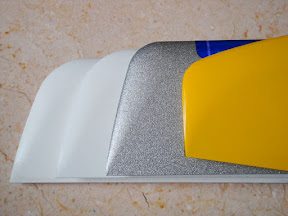Did a very short write-up on it.
 |
| From savox |
 |
| From savox |
 |
| From savox |
 |
| From savox |
 |
| From savox |
 |
| From savox |
One thing I really like about these is that they are using the typical 3mm screw size for servo horn screw.
 |
| From savox |
 |
| From savox |
 |
| From savox |
 |
| From savox |
 |
| From savox |
 |
| From savox |
 |
| From savox |
 |
| From savox |
My 2cents on the servo...
Packaging/Hardware
Very nicely sealed plastic box that assures you that it is brand new and never been opened before, definately one notch above all the others out there. Something that even the more expensive servos out that can't match. The hardware supplied is definately ample and the horns are quite stiff too.
Build quality
These are actually one notch above the ino-lab 760mg that I had in this heli. Plastic is thicker and metal gear appears to be better machined than the ino-lab ones. However, one thing that that I don't understand is, why do they just so stubbornly refuse to goop the servo wire-PCB solder joint. My cheaper hitec's is like that, my ino-lab's is also like that. Hai. One thing I am a bit puzzled is why the servo screws got rubber o-ring, but servo case don't have? Heat sink seems to be not secured to the motor inside, which might reduce the efficiency of the heatsink. Overall, acceptable for me, but don't expect the build quality of a expensive futaba BLS, but those are like so much more expensive and made in Taiwan also.
On the bench
Initially I thought the servo was going to be quite bad in ability to hold position under load because of that video by Chance where you can see the swash jumping up and down when he use his finger to press. I of course have the same problem, but what I found out is that it is actually due to somewhere in the linkage along the servo to swash coz the servo arm didn't appear to move that much when I force them.
Resolution wise, there is slight amount of jumpiness through the swash movement, just very very slight. Not sure where the jumpiness is coming from, because the servos actually has decent resolution from the fact that I can get it to move with every 0.5% change of the pitch curve point value and my TX pitch curve point value actually ranges from -152.5% to 152.5%.
Speed wise I really cannot get the speed in the video, probably due to my finger and voltage. I am running 5.3v now, which probably slows it down to something like 0.095s w/o load.
I can't really give any flight report yet, coz I haven't been flying for quite a while. After a short 5mins flight this morning, all I can say is, they draw pretty much the same amount of power as other coreless digital, nothing significantly more or less. Control and resolution seems perfectly fine to me, but don't take my word for it, coz right now even a 50 size is very powerful to me.
After a bit more time...
The servos are still working fine and not sure why, starting to get those jumpy movement on the bench also. Not as bad as the ino-lab though. In flight cannot feel anything. They consume very little power and run cool. Very smooth flying servos that work for me.
Very happy with the camera also. All except photo no.10 were taken with the 50mm f/1.8.



































































